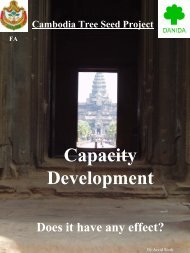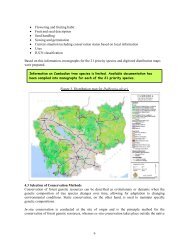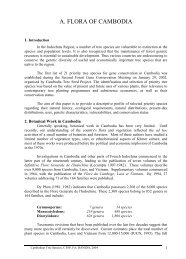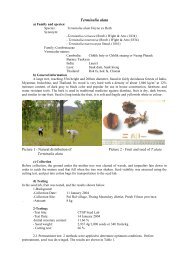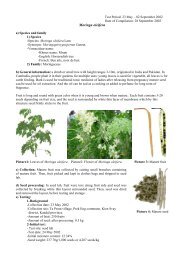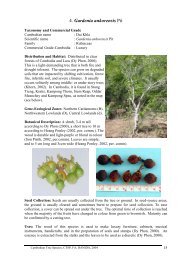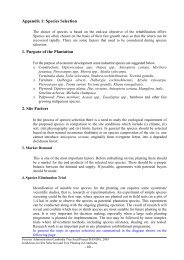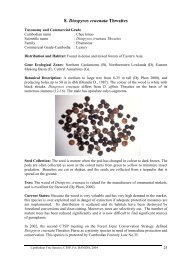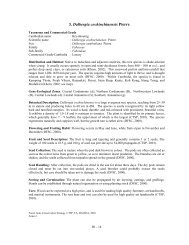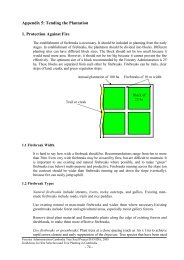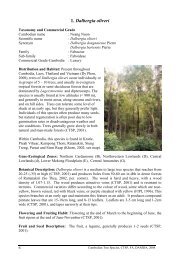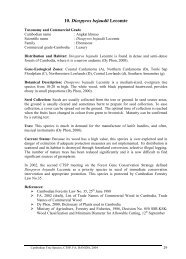Proceedings of National Workshop on Priority Tree Species
Proceedings of National Workshop on Priority Tree Species
Proceedings of National Workshop on Priority Tree Species
You also want an ePaper? Increase the reach of your titles
YUMPU automatically turns print PDFs into web optimized ePapers that Google loves.
2. Knowledge and capabilities <str<strong>on</strong>g>of</str<strong>on</strong>g> selected staff at relevant nati<strong>on</strong>al instituti<strong>on</strong>s upgraded<br />
and methods and technologies imparted to seed users.<br />
3. Methods, documentati<strong>on</strong> and technologies for collecti<strong>on</strong>, handling and storage <str<strong>on</strong>g>of</str<strong>on</strong>g><br />
forest seed improved.<br />
4. <str<strong>on</strong>g>Nati<strong>on</strong>al</str<strong>on</strong>g> and regi<strong>on</strong>al strategies for c<strong>on</strong>servati<strong>on</strong> and use <str<strong>on</strong>g>of</str<strong>on</strong>g> genetic resources <str<strong>on</strong>g>of</str<strong>on</strong>g><br />
indigenous priority species initiated. (See Annex 5 for details).<br />
Address by Mr. V<strong>on</strong>g Sarun, Director <str<strong>on</strong>g>of</str<strong>on</strong>g> Forest and Wildlife Research Institute <strong>on</strong> the<br />
c<strong>on</strong>tibuti<strong>on</strong> <str<strong>on</strong>g>of</str<strong>on</strong>g> priority tree species to forest sector in Cambodia. Before 1970, Cambodia<br />
had 13,227,100 ha <str<strong>on</strong>g>of</str<strong>on</strong>g> forest distributed all over the country. Through nearly 30 years,<br />
according to the data from GIS/RS unit in 1997, the forestland has changed (as shown in a<br />
table).<br />
Forest rehabilitati<strong>on</strong> program<br />
The objective <str<strong>on</strong>g>of</str<strong>on</strong>g> RGC’s forest rehabilitati<strong>on</strong> program is:<br />
-Replanting barren land for the effective c<strong>on</strong>servati<strong>on</strong> <str<strong>on</strong>g>of</str<strong>on</strong>g> ecosystems,<br />
biodiversity and envir<strong>on</strong>ment and increase watershed potentials<br />
-Bringing barren land into effective producti<strong>on</strong> to c<strong>on</strong>tribute in the poverty<br />
alleviati<strong>on</strong>, and<br />
-Str<strong>on</strong>gly promoting fast growing tree species planting movement for<br />
envir<strong>on</strong>mental improvement and wood self-sufficiency.<br />
Program target: In the five-year plan (2001-2005) Department <str<strong>on</strong>g>of</str<strong>on</strong>g> Forestry and Wildlife<br />
planned to plant 50,000 ha annually.<br />
Advantages <str<strong>on</strong>g>of</str<strong>on</strong>g> species selecti<strong>on</strong><br />
There are several observati<strong>on</strong>s <strong>on</strong> which species should be planted in order to achieve the<br />
program. In general, the species selected for planting are to:<br />
-Enable genetic c<strong>on</strong>servati<strong>on</strong> (in-situ c<strong>on</strong>servati<strong>on</strong> and ex-situ c<strong>on</strong>servati<strong>on</strong><br />
combined with reforestati<strong>on</strong> program),<br />
-Match plant with site for increasing forest quality,<br />
-Meet a variety <str<strong>on</strong>g>of</str<strong>on</strong>g> demands <str<strong>on</strong>g>of</str<strong>on</strong>g> a large-scale reforestati<strong>on</strong> program.<br />
-Meet the need <str<strong>on</strong>g>of</str<strong>on</strong>g> end-user<br />
In the past reforestati<strong>on</strong> in Cambodia was small scale with planting rate <str<strong>on</strong>g>of</str<strong>on</strong>g> approximately<br />
500 ha per year and species were planted without studying origin or provenance. The<br />
species planted before were:<br />
a) Exotic species: Acacia sp., Eucalyptus sp. and Tect<strong>on</strong>a grandis.<br />
b) Indigenous species: Anisoptera glabra, Afzelia xylocarpa, Aquilaria crassna,<br />
Azadirachta indica, Cassia siamea, Dalbegia bariensis, Hopea odorata, Khaya<br />
senegalensis, Pterocarpus sp., Terretia javanica and Peltphorum ferruginum.<br />
Seed selecti<strong>on</strong> methods<br />
<strong>Tree</strong> seed is the important comp<strong>on</strong>ent in a reforestati<strong>on</strong> program, because through the<br />
correct selecti<strong>on</strong> we can get more effective producti<strong>on</strong> with less expense. In order to<br />
produce seed or seedlings meeting the need <str<strong>on</strong>g>of</str<strong>on</strong>g> the market, the seed producers and<br />
c<strong>on</strong>sumers have to prioritise tree species. After recognizing the priority tree seed species<br />
for the c<strong>on</strong>sumers, producers must produce seed based <strong>on</strong> technical procedures to provide<br />
seed with high quality and <str<strong>on</strong>g>of</str<strong>on</strong>g> known provenance (refer annex 6).<br />
8



